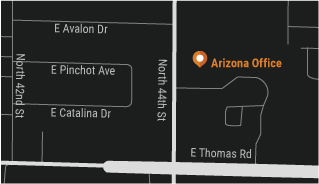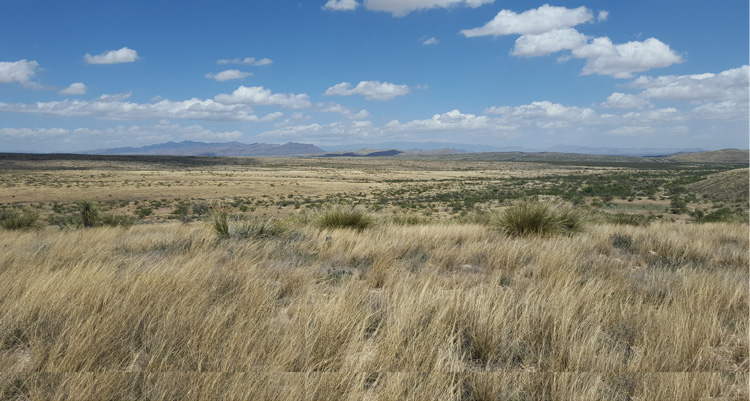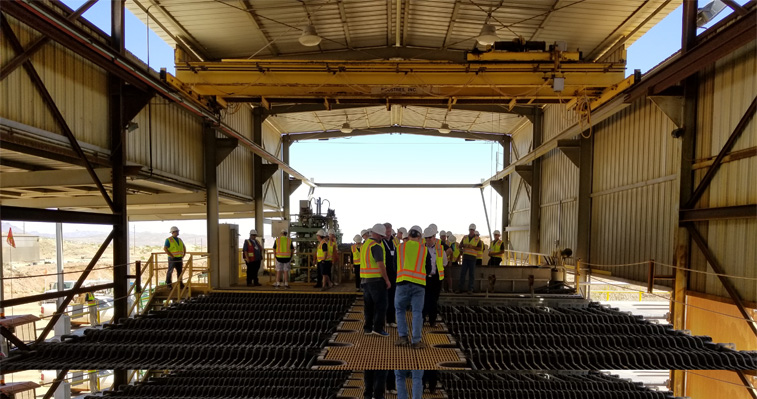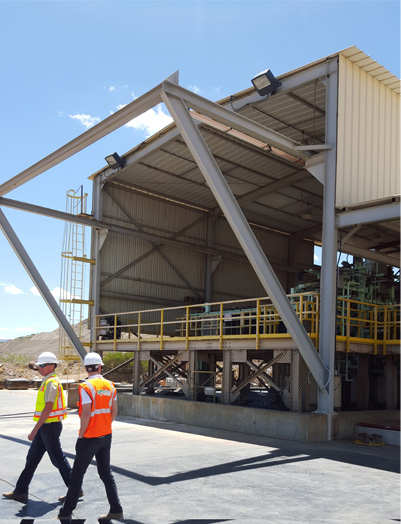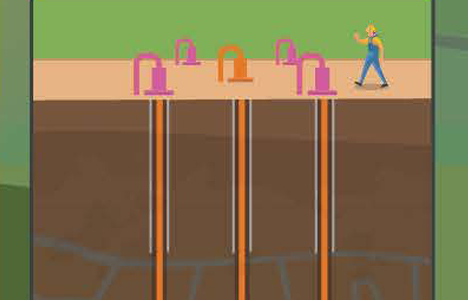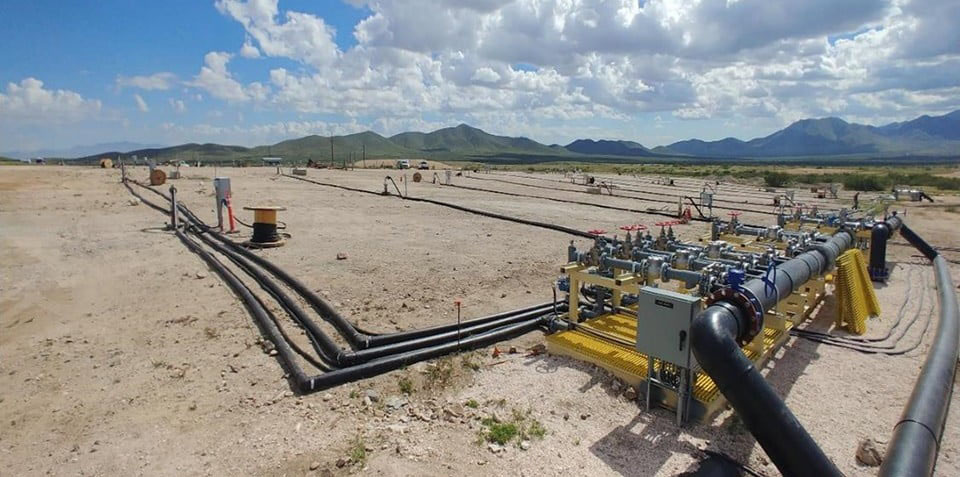Phoenix, Arizona--(Newsfile Corp. - September 9, 2021) - Excelsior Mining Corp. (TSX: MIN) (FSE: 3XS) (OTCQX: EXMGF) ("Excelsior" or the "Company") is pleased to provide a comprehensive update on the Company, which includes an update on the Gunnison Copper Project, the intent to restart the Johnson Camp Mine and an announcement of Exploration and Development Properties, including the release of a Preliminary Economic Assessment on the Strong and Harris copper-zinc-silver deposit. All dollar values in this press release are in United States dollars.
Excelsior's President & CEO, Dr. Stephen Twyerould states, "We are very encouraged with some recent developments at the Gunnison Copper Project. Production flow rates have been challenged due to the impact of carbon dioxide gas but the Company has identified a process change that has demonstrated a 1000% improvement in flow rates in test wells. Full implementation of all changes to optimize fluid flows will require some additional time and capital to complete; however, the updated economics on the Gunnison Project incorporating reasonable assumptions for these changes shows the Project remains extremely robust. In addition, in the near term, the Company intends to supplement copper production by restarting operations of the historic Johnson Camp copper oxide open pits."
Dr. Twyerould continued, "Gunnison remains the flagship property for Excelsior; however, the Company has a robust portfolio of additional properties in Arizona, both within the existing permitted property boundaries and beyond. The Company has been preparing to bring these properties to the forefront alongside Gunnison as production ramps up. The Company has completed a preliminary economic assessment on its Strong & Harris copper-zinc-silver property that has demonstrated excellent economics for future development utilizing conventional mining methods. The Company is focused on maximizing the potential of all of its assets to generate additional long term shareholder value."
Gunnison
As previously disclosed, Excelsior's Gunnison Copper Project has experienced delays due to carbon dioxide gas bubbles reducing injection flows and preventing timely ramp-up to name-plate production. The gas bubbles are the result of the interaction of the weak acid injection with finite amounts of secondary calcite within the permeable fracture system.
Cycling periods of fresh water injection with acid injection and recovery has demonstrated sustained flow improvements on individual wells. For example, acid injection flow rates on individual test wells increased from lows of around 20 gallons per minute ("gpm") to sustainable highs around 200 gpm. Recovery flows also increased from around 10 gpm to sustainable recovery flows around 110 gpm. Both representing an approximate 1,000 percent increase in flow rates.
Until recently, the fresh water cycling has been focused on a central 5-spot of wells. Although not completely removed, the calcite appears to be dissolved enough for the wells to operate and flow sufficiently and as a result fresh water cycling has been moved to another 5-spot of wells to improve their fluid flows.
Excelsior believes the problem to be finite because as the calcite interacts with the acid it is dissolved and leaves the system. However, due to water conservation and evaporation capacity, individual well flushing with fresh water is not considered the optimal long-term solution.
The preferred path involves flushing with neutralized raffinate, which does not require additional water or evaporation infrastructure, however does require additional solution treatment infrastructure. The initial capital cost of this infrastructure is estimated at around $13 million ($45 million life of mine) and includes additional piping and pond modifications.
It is estimated operating costs will also increase by approximately $0.185/lb over the life of the mine due to the inclusion of one year of pre-production rinsing for all current and new wells, and the cost of operating the raffinate neutralization plant. Excelsior expects it will be able to ramp-up to name plate production once the installation and application of this infrastructure and pre-production wellfield conditioning is completed. Excelsior is in process of preparing an updated technical report on the Gunnison project (the "Updated Technical Report") that will update for these developments. Based on initial modelling, at $3.50/lb copper prices, the Gunnison Project would have an after tax NPV (7.5% discount rate) of $983 million and an IRR of 36%. The Company is also exploring additional options to accelerate the removal of CO2, potentially at significantly lower capital and operating costs.
| Cu Price US$/lb | NPV Pre-Tax @ 7.5% | IRR | NPV After-Tax @ 7.5% | IRR |
| $ 2.75 | $ 779,000 | 28% | $ 589,000 | 25% |
| $ 3.25 | $ 1,126,000 | 36% | $ 853,000 | 33% |
| $ 3.50 | $ 1,298,000 | 40% | $ 983,000 | 36% |
| $ 3.75 | $ 1,471,000 | 44% | $ 1,113,000 | 40% |
| $ 4.00 | $ 1,644,000 | 47% | $ 1,242,000 | 43% |
Robert Winton, SVP Operations and General Manager for the Company noted that, "With the inclusion of the legacy Johnson Camp open pits, the potential for mining of the Peabody Sill and Strong and Harris deposit, and with the re-vamp of the Gunnison ISR Project, Excelsior has the potential to be a larger and longer-term producer than previously envisioned. The traditional mining assets also give Excelsior the time required to optimize the Gunnison ISR project."
Johnson Camp Mine
Excelsior's Johnson Camp Mine is a historical copper producer with open pit mining at the Johnson Camp mine occurring from approximately 1975 to 2010. Excelsior acquired the Johnson Camp Mine initially for its infrastructure but also based on the remaining mineralization. To achieve additional copper production as Gunnison resolves its ramp-up issues, Excelsior intends to restart operations of the historic Johnson Camp copper oxide open pits. These open pits were most recently mined in 2010 by Nord Resources ("Nord") and technical information describing their operations can still be found on Nord's SEDAR profile.
Excelsior foresees a smaller operation to Nord's, focusing on exposed copper oxides within the existing open pits and high-value oxides in local extensions. No new infrastructure will be required, with the exception of a new leach pad and minor piping and pumping facilities. Operations could provide up to 5 years of copper production at the 25 million pounds per annum capacity of the existing SXEW plant. Excelsior expects that copper cathode production from the Johnson Camp open pits will commence in the second half of 2022. Production from Johnson Camp will increase the Company's overall production as the Gunnison Project ramps up to full production.
More details will be provided in the Updated Technical Report.
Strong & Harris
The Company's most advanced exploration property is the Strong and Harris copper-zinc-silver deposit located just 1.5 miles (2.4km) north of Excelsior's Johnson Camp SX-EW facility, and directly adjacent to the location of the potential new leach pad.
Mining of the Strong and Harris deposit would be by traditional open pit with high-grade underground mining of the remaining sulfides at the bottom of the pit. A Preliminary Economic Assessment ("PEA") has been completed by Mine Development Associates, a division of RESPEC (MDA), the highlights of which are tabulated below assuming a $3.50/lb. copper price, $1.28/lb. zinc price, and $110/ton acid cost.
| Mine Life | ~7 years |
| Material Mined | ~54 M ton |
| Cu/Zn Grades | 0.56% / 0.68% |
| Cu/Zn Produced | 437 M lb / 575 M lb |
| Initial Capital | $328 million |
| Operating Costs ($/lb CuEq) | $1.76 |
| Average Cu/Zn annual production | 62 Mlbpa / 82 Mlbpa |
| Pre-Tax NPV/IRR (8% discount rate) | $325M / 25% |
The table below sets out the sensitivities of the NPV and IRR to copper price:
| Cu Price US$/lb | NPV Pre-Tax @ 8% | IRR | NPV After-Tax @ 8% | IRR |
| $ 3.00 | $ 111,387 | 14% | $ 38,999 | 10% |
| $ 3.25 | $ 218,426 | 19% | $ 113,438 | 15% |
| $ 3.50 | $ 325,466 | 25% | $ 186,958 | 19% |
| $ 3.75 | $ 432,505 | 30% | $ 260,306 | 23% |
| $ 4.00 | $ 539,544 | 35% | $ 333,264 | 27% |
The PEA is preliminary in nature and includes inferred mineral resources that are considered too speculative geologically to have the economic considerations applied to them that would enable them to be categorized as mineral reserves. There is no certainty that the conclusions reached in the PEA will be realized. Mineral resources that are not mineral reserves do not have demonstrated economic viability.
The Company's next steps with Strong and Harris are a drill program targeting adjacent geophysical anomalies with the goal of expanding the mineral resource, metallurgical test work and completion of a feasibility study.
Mineral Resources
The Strong and Harris Mineral Resources are provided in the table below.
| % Cu Cutoff | Tons | % Cu | % CuOx | % Zn | oz Ag/ton | lbs Cu | lbs CuOx | lbs Zn | oz Ag |
| 0.1 | 76,161,000 | 0.52 | 0.33 | 0.56 | 0.12 | 794,049,000 | 500,155,000 | 858,425,000 | 9,515,000 |
| 0.2 | 54,187,000 | 0.67 | 0.42 | 0.70 | 0.15 | 731,493,000 | 458,808,000 | 757,677,000 | 7,900,000 |
| 0.4 | 34,848,000 | 0.90 | 0.56 | 0.87 | 0.17 | 624,078,000 | 390,701,000 | 605,666,000 | 5,768,000 |
| 0.6 | 22,176,000 | 1.12 | 0.71 | 1.05 | 0.18 | 498,599,000 | 314,910,000 | 463,692,000 | 4,050,000 |
| 0.8 | 12,280,000 | 1.48 | 0.94 | 1.35 | 0.20 | 362,913,000 | 231,657,000 | 330,633,000 | 2,455,000 |
| 1 | 7,077,000 | 1.91 | 1.25 | 1.77 | 0.23 | 271,046,000 | 176,599,000 | 250,717,000 | 1,645,000 |
- Mineral resources that are not mineral reserves do not have demonstrated economic viability.
- Mineral resources are reported at a 0.1 % Cu cut-off (indicated in bold lettering and italics in the table) in consideration of potential open-pit mining and heap-leach and flotation processing. The Mineral Resource is constrained by a pit optimization.
- All other sensitivity cut-offs are applied to the in-pit Mineral Resource and represent subsets of the Mineral Resource.
- Rounding as required by reporting guidelines may result in apparent discrepancies between tons, grades, and contained metal content.
- The effective date of the Mineral Resource estimate is September 9, 2021.
- See additional resource estimate notes below.
The estimate is classified as an inferred mineral resource, consistent with the CIM definitions referred to in National Instrument 43-101. Excelsior is not aware of any environmental, permitting, legal, title, taxation, socio-political, marketing or other issues which may materially affect its estimate of mineral resources.
PEA Assumptions
The PEA is based on conventional open pit mining with a contract miner using 100-ton capacity haul trucks and wheeled loaders. Pit designs include 4 pit phases to achieve the ultimate pit. Waste is planned to be stored in a single waste rock facility located to the east of the pit.
Processing assumes leaching of oxide and lower-grade mixed material in a single leach pad located to the west of the ultimate pit. In addition, higher-grade mixed material and sulfide material are planned to be processed using flotation and concentration of material. The concentrate would be transported to a suitable smelter. A conceptual tailings facility of suitable capacity is located to the west of the ultimate pit buttressed to the north by the heap leach pad. Construction of the tailings embankment is assumed to be completed using mined waste material.
A processing rate of 20,000 tons per day for run-of-mine ("ROM") leaching. ROM leaching costs were estimated to be $5.62 per ton processed with a recovery rate of 92.3% for soluble copper and 82.3% for zinc. Acid costs are estimated to be $110 per ton and are included in the ROM leaching cost.
Flotation processing rate of 5,000 was used in the PEA assuming a cost of $11.70 per ton. In addition, other costs are applied including: $76/ton of copper concentrate, $140/ton of zinc concentrate and $6.00 per ton penalties. These costs were converted into $/ton processed based on a mass pull of 4% into the concentrate. This yields: $3.04, $5.60, and $0.24 per ton processed for treatment, transportation, and penalties respectively. Flotation recoveries for copper of 80.1% and 84.0% were used for mixed and sulfide respectively. Zinc recoveries of 69.7% and 89.0% were used for mixed and sulfide material respectively.
Royalties on production were applied using a 3% GRR with the exception of Sections 23 and 24 which carry a royalty of 17.785% GRR (including the impact of the stream). Mineralization from these Sections represents approximately 2.5% of the total $3.50/lb. copper price constrained PEA open pit.
Mining costs of $2.50 per ton were assumed which are based on similar projects with actual contractor quotations. The total mining cost assumption used is $2.50/ton mined including $0.03/ton for mine management.
Mine design was completed in 3-D and included 20 foot bench heights, 50 foot wide ramp at 1 in 9 grade, ore and waste scheduling and trucking distances.
The economic parameters discussed above were used for pit optimizations. Four pit phases were designed based on the pit optimizations. An NSR equivalent value in $/ton was developed in the resource model and NSR cutoff grades were applied to the resources inside of the pit designs.
Mineral Resource Estimation Methods
The mineral resource estimate was completed in accordance with the Canadian Institute of Mining, Metallurgy and Petroleum ("CIM") Standards on Mineral Resources and Mineral Reserves, adopted by the CIM Council, as amended. Estimation methods are summarized below:
- The copper, zinc, and silver mineral resources at the Strong and Harris project were modeled and estimated by:
- Developing a geological model, reflecting stratigraphic control of mineralization hosted in receptive rocks;
- Developing oxidation surfaces based on the soluble copper total copper ratios from the assay data;
- Evaluating the drill data statistically;
- Interpreting domain polygons on sets of cross sections spaced at 200-foot intervals for copper, zinc, and silver;
- Coding a block model comprised of 20 x 20 x 20 (x, y, z) foot blocks to the domains using the sectional mineral-domain polygons;
- Analyzing the modeled mineralization geostatistically to aid in the establishment of estimation and classification parameters;
- Interpolating copper, soluble copper ratios, zinc, and silver grades into the model blocks using the mineral- domain coding to explicitly constrain the grade estimations; and
- Evaluating the resulting model in detail prior to finalizing the mineral resource estimation.
- The Strong and Harris Deposit Mineral Resources have been constrained to lie within optimized pit shells created using a copper price of USD $3.50/pound of copper and $1.28/pound of zinc. Silver resources were not considered in the constraint. Additional inputs for the pit-optimizations include: Mining - $2.00/ton mined, heap leaching - $5.00/ton processed, flotation- $9.00/ton processed; and G&A cost of $0.83/ton at an assumed 7.2 million tons per year processing rate. Copper and zinc recoveries are based on historical test data. Leaching recovery rates of 92.3% for soluble copper and 82.3% for zinc were used in the optimization. Flotation recoveries for copper of 80.1% and 84.0% were used for mixed and sulfide material respectively. Zinc recoveries of 69.7% and 89.0% were used for mixed and sulfide material respectively.
- A refining cost of $0.08/pound and a 3.0% gross revenue royalty were also applied.
- The mineral resource estimate for the Strong and Harris deposit is based on results from 152 drill holes totalling 130,678 feet (ft).
- The mineral resource estimate is contained within a block model of the deposit covering a surface area of 3.91 square miles and to a maximum depth of 2,820 feet below the topographic surface. The major geologic formations and oxidization types are incorporated into the block model based on the drill hole intercept data.
Strong and Harris Expansion Potential
The mineralization at Strong and Harris is open down plunge and a recent airborne magnetic survey shows a look-alike magnetic anomaly, under cover, due south of the known deposit. The adjacent Peabody Sill is open down dip and along strike and shows a contiguous induced polarization anomaly along strike and under cover to the north.
Additional Exploration Properties
Excelsior has also assembled a number of exploration and development properties in the Cochise Mining District. The Cochise Mining District hosts several known copper and copper-zinc deposits with production dating back to the early 1900s. The district has never been consolidated into one entity until Excelsior completed this task by acquiring firstly the Johnson Camp Mine and then Strong and Harris. No modern exploration has occurred in the district which has substantial geological and drilling data sets. Given this land consolidation and available data sets, Excelsior decided in 2020 to initiate an exploration program to capitalize on the opportunities available to it. Excelsior has identified several magnetic and/or electrical geophysical anomalies on Excelsior's properties in the Cochise Mining District.
Further, Excelsior also has landholdings in the historic Turquoise Mining District, also referred to as the Courtland District or the Courtland-Gleeson District, located approximately 30 miles southeast of the Johnson Camp Mine. The district has experienced a long history of mining and exploration dating back to the late 1800s. Historic mining and many past exploration programs focused on shallow CRD mineralization hosted within the lower Paleozoic sediments in the district. Previous workers including Bear Creek Mining and Anglo American determined the CRD mineralization to be part of a larger porphyry system and identified the district as having significant potential for discovery of a world class porphyry copper deposit.
In 2021, Excelsior obtained a complete dataset of exploration work conducted by Anglo American in the Courtland-Gleeson area. These data have been reviewed by Excelsior staff and contract geophysicists as part of due diligence and technical assessment of the district. Additionally, compilation of historic reports and data from numerous sources including the USGS, Bear Creek Mining, Santa Fe Pacific, and other workers has been used to assess the district.
About Excelsior Mining
Excelsior "The Copper Solution Company" is a mineral exploration and production company that owns and operates the Gunnison Copper Project in Cochise County, Arizona. The project is a low cost, environmentally friendly in-situ recovery copper extraction project that is permitted to 125 million pounds per year of copper cathode production. Excelsior also owns the past producing Johnson Camp Mine and a portfolio of exploration projects, including the Peabody Sill and the Strong and Harris deposits.
Excelsior's technical work on the Gunnison Copper Project and Johnson Camp is supervised by Stephen Twyerould, Fellow of AUSIMM, President & CEO of Excelsior and a Qualified Person as defined by National Instrument 43-101. Mr. Twyerould has reviewed and approved the technical information contained in this news release related to the Gunnison Copper Project and Johnson Camp and underlying sampling, analytical and test data.
The technical information contained in this news release under the heading "Additional Exploration Properties" has been reviewed and approved by Roland Goodgame, Member of the Australian Institute of Geoscientists MAIG, SVP Business Development of Excelsior, and a Qualified Person as defined by National Instrument 43-101. Mr. Goodgame has reviewed and approved the technical information contained in this news release under the heading "Additional Exploration Properties" and underlying sampling, analytical and test data.
The technical information contained in this news release with respect to Strong & Harris has been reviewed and approved by the following Independent Qualified Persons from MDA, a division of RESPEC:
- Mr. Jeff Bickel, C.P.G., of MDA, Reno, Nevada (geology and mineral resource)
- Mr. Michael Gustin, PhD., P.Geo, of MDA, Reno, Nevada (geology and mineral resource)
- Robert Bowell, PhD, C.Chem, C.Geol, SRK Consulting (UK) Limited, Cardiff, Wales, UK (mineral processing and metallurgical testing, recovery methods)
- Mr. Thomas L. Dyer, P.E., of MDA, Reno, Nevada (mining methods, capital and operating costs, and economic analysis)
Additional information about the Gunnison Copper Project can be found in the technical report filed on SEDAR at www.sedar.com entitled: "Gunnison Copper Project, NI 43-101 Technical Report, Feasibility Study" dated effective December 17, 2016.
For more information on Excelsior, please visit our website at www.excelsiormining.com.
For further information regarding this press release, please contact:
Excelsior Mining Corp.
Concord Place, Suite 300, 2999 North 44th Street, Phoenix, AZ, 85018.
Shawn Westcott
T: 604.365.6681
E: This email address is being protected from spambots. You need JavaScript enabled to view it.
www.excelsiormining.com
Cautionary Note Regarding Forward-Looking Information
This news release contains "forward-looking information" concerning anticipated developments and events that may occur in the future. Forward looking information contained in this news release includes, but is not limited to, statements with respect to: (i) expectations for the resolution of carbon dioxide issues and increased flow rates; (ii) the future development plans for the Gunnison Project; (iii) operating and capital costs estimates, along with the economics of the Gunnison Project; (iv) the intention to mine Johnson Camp and future production therefrom; (v) the results of the Preliminary Economic Assessment on the Peabody Sill and Strong & Harris; and (vi) future development of exploration projects in the Cochise Mining District and Courtland-Gleason.
In certain cases, forward-looking information can be identified by the use of words such as "plans", "expects" or "does not expect", "budget", "scheduled", "estimates", "forecasts", "intends", "anticipates" or "does not anticipate", or "believes", or variations of such words and phrases or state that certain actions, events or results "may", "could", "would", "might", "occur" or "be achieved" suggesting future outcomes, or other expectations, beliefs, plans, objectives, assumptions, intentions or statements about future events or performance. Forward-looking information contained in this news release is based on certain factors and assumptions regarding, among other things, the estimation of mineral resources and mineral reserves, the realization of resource and reserve estimates, expectations and anticipated impact of the COVID-19 outbreak, copper and other metal prices, the timing and amount of future development expenditures, the estimation of initial and sustaining capital requirements, the estimation of labour and operating costs (including the price of acid), the availability of labour, material and acid supply, receipt of and compliance with necessary regulatory approvals and permits, the estimation of insurance coverage, and assumptions with respect to currency fluctuations, environmental risks, title disputes or claims, and other similar matters. While the Company considers these assumptions to be reasonable based on information currently available to it, they may prove to be incorrect.
Forward looking information involves known and unknown risks, uncertainties and other factors which may cause the actual results, performance or achievements of the Company to be materially different from any future results, performance or achievements expressed or implied by the forward-looking information. Such factors include risks inherent in the construction and operation of mineral deposits, including risks relating to changes in project parameters as plans continue to be redefined including the possibility that mining operations may not be sustained at the Gunnison Copper Project, risks relating to variations in mineral resources and reserves, grade or recovery rates, risks relating to the ability to access infrastructure, risks relating to changes in copper and other commodity prices and the worldwide demand for and supply of copper and related products, risks related to increased competition in the market for copper and related products, risks related to current global financial conditions, risks related to current global financial conditions and the impact of COVID-19 on the Company's business, uncertainties inherent in the estimation of mineral resources, access and supply risks, risks related to the ability to access acid supply on commercially reasonable terms, reliance on key personnel, operational risks inherent in the conduct of mining activities, including the risk of accidents, labour disputes, increases in capital and operating costs and the risk of delays or increased costs that might be encountered during the construction or mining process, regulatory risks including the risk that permits may not be obtained in a timely fashion or at all, financing, capitalization and liquidity risks, risks related to disputes concerning property titles and interests, environmental risks and the additional risks identified in the "Risk Factors" section of the Company's reports and filings with applicable Canadian securities regulators.
Although the Company has attempted to identify important factors that could cause actual actions, events or results to differ materially from those described in forward-looking information, there may be other factors that cause actions, events or results not to be as anticipated, estimated or intended. Accordingly, readers should not place undue reliance on forward-looking information. The forward-looking information is made as of the date of this news release. Except as required by applicable securities laws, the Company does not undertake any obligation to publicly update or revise any forward-looking information.

To view the source version of this press release, please visit https://www.newsfilecorp.com/release/95969


